
Wine Culture and Information since 2002 - Volume 22
 Wine Culture and Information since 2002 - Volume 22 |
|
Contrasts of Monica di Sardegna and Bardolino SuperioreThis month we are pouring in our glasses two red wines, produced in distant territories and with different grapes both in wine making and sensorial terms |
|
Sardinia is an enological treasure chest of extraordinary value. Veneto – of course – is no less as the wealth of grapes and wines found in this region is among the most significant ones in Italian enology. Two regions and territories that are in any case very different and, from a wine making and viticultural point of view, express very distant cultures and traditions. The diversity, in both cases, is also strongly expressed within their respective territories, with a wealth of grapes, often found in very small areas, something occurring, in a particular, in Sardinia. One could say – using a metaphor that, in this case seems to be appropriate – the wine scene of Sardinia and Veneto is in continuous ferment, given the wealth of very different styles of wines. Of course, this is the result determined not only by the respective enological cultures but, in particular, by the richness and peculiarities of environment and climate. Both regions are also rich in indigenous varieties and have created very deep and unrepeatable ties with their respective territories. This is what happened with the grapes used for the wines of this month's tasting by contrast, Monica di Sardegna and Bardolino Superiore. The Sardinian wine is produced with the grape of the same name and is considered among the oldest varieties present in the island. Bardolino Superiore, a wine from Veneto with a Denominazione d'Origine Controllata e Garantita (Denomination of Controlled and Guaranteed Origin, DOCG), is made of Corvina, Rondinella and Molinara, indigenous varieties that are also used in the nearby Valpolicella area. For completeness, in Bardolino Superiore – just like Valpolicella – is also provided for the the use of Corvinone, also in this case, an autochthonous variety of Veneto. In both cases, these are wines having a strong territorial identity and that well represents the culture and enological tradition of the respective regions.
|
|
Monica di Sardegna is recognized – according to the Italian wine quality system – as a DOC Denominazione d'Origine Controllata wine (Denomination of Controlled Origin). The production of this wine is allowed in the whole territory of Sardinia. As it usually happens in many other DOCs in Italy, Monica must be used for a minimum of 85% and the remaining part can be made up of non-aromatic red berried grapes allowed in Sardinia. Monica – the grape with which is made this interesting wine – is considered among the oldest native varieties of Sardinia, which origins are controversial and uncertain. This ancient red berried variety is present in all the provinces of Sardinia and takes part in the production of many red wines of the island both alone and blended to other grapes. Monica is also present in the composition of some DOC wines of the region, such as Mandrolisai and the DOC reserved for Cagliari, the capital of the island. The origins of Monica are unclear and all agree in the fact it is supposed to have been introduced to the island many centuries ago. Some support the idea Monica was introduced to Sardinia by Camaldolese monks, who were using it for the production of wine to be used in the celebration of liturgies. According to others, the grape is supposed to have been introduced in 1600s by the Aragonese and known by the name of Morillo – or Uva Mora – because of the dark color of the berries. It is supposed, in fact, that today's name derives from the linguistic corruption of these terms and that have been adapted with time in Italian to Monica. This Sardinian variety makes wines of sure enological interest, having a good versatility which can be used both for table red wines and for sparkling ones, including sweet and fortified wines. The wines produced with Monica grape are characterized by an average structure and low acidity, qualities emphasized by producers – in general – who make wines destined to an immediate consumption. It should however be noted Monica has a good potential to evolve with time, especially in case it is aged in cask.
|
||||
|
The wines of Bardolino – a town on the shores of Lake Garda – are among the best known in Veneto and the province of Verona. The wines of this territory are also produced in the hinterland of the province of Verona, so much so as to define sub-areas and which strongly distinguish the wines of Bardolino denomination. In this regard, it should be said in this territory are defined two denominations – Bardolino and Bardolino Superiore – the former recognized as a Denominazione d'Origine Controllata (Denomination of Controlled Origin, DOC) the latter with the higher “Guaranteed” rank (DOCG). The grapes making up Bardolino Superiore are practically the same as for the wines of the nearby Valpolicella, that is Corvina, Rondinella and Molinara. To these grapes can also be added – for a maximum of 20% – non-aromatic red berried varieties allowed for cultivation in the province of Verona. Specifically, and according to the production disciplinary, Bardolino Superiore is made up of 35-80% of Corvina, 10-40% of Rondinella and a maximum of 15% of Molinara. As for Corvina, 20% of its share can be replaced by Corvinone. Bardolino wines are historically characterized by their finesse and immediacy, medium body and are usually intended for immediate consumption. The exception to this style is represented by the wines belonging to the “Superiore” denomination, which are characterized both by a fuller and more robust body, and by the potential of aging for longer times, also thanks to the use of wooden barrels and to the vocation of particular areas. Bardolino wines have a long history and tradition, and were among the first ones in Veneto to reach the DOC rank, in particular, Bardolino Superiore has been the first red wine of Veneto to reach DOCG status in 2001. In regard of the “light and immediate” style of Bardolino wines, it is supposed to come from the enological tradition of the ancient Celtic people, who were used to make light and thirst-quenching wines. A style which is still common today and in general terms in Bardolino DOC wines, while those belonging to Bardolino Superiore DOCG denomination are usually distinguished by a more robust structure, frequently accentuated by the use of the cask, both for fermentation and for aging.
|
Before pouring the wines of this month's tasting by contrast into the glasses, we proceed with the choice of the two bottles we will examine. In this regard, it should be noted that – in general terms – Bardolino Superiore is aged in part or completely in cask and, often, in barrique. This enological characteristic will influence the choice of Monica di Sardegna, as, also in this case, we will choose a wine aged in the same type of container. Moreover, we will pay attention to the composition of the two wines as, in both cases, and as often happens for Denominazione d'Origine Controllata DOC wines, it is allowed the use of different grapes. As for Monica di Sardegna, we will make sure the wine is produced with this grape alone and, as already mentioned, aged in cask. As for Bardolino Superiore, we will choose a bottle produced with Corvina, Rondinella and Molinara, also in this case aged in cask. The two wines belong to the most recent vintage and are poured into tasting glasses at a temperature of 18 °C. (65 °F) Let's pour the two wines into their respective glasses and start our tasting by contrast. The first wine we will examine is Monica di Sardegna, therefore, by tilting the glass over a white surface, we proceed with the evaluation of its appearance, that is color and transparency. We observe the base of the glass in which we can see a bright ruby red color and, by placing an object between the glass and the white surface, we observe a moderate transparency. Let's now look at the edge of the wine towards the opening of the glass in order to evaluate the nuance: Monica di Sardegna confirms the ruby red color, sometimes characterized by purple notes. Let's now pass to the evaluation of the appearance of Bardolino Superiore by tilting its glass, just like the previous wine, over the white surface. The color of the wine from Veneto – observed at the base – reveals an intense ruby red hue and a moderate transparency, not much different from the Sardinian wine. The nuance of Bardolino Superiore, observed towards the opening of the glass, is characterized by a ruby red color, sometimes tending to garnet. The olfactory profiles of Monica di Sardegna and Bardolino Superiore offer the nose of the taster rather different and distant sensations. We must, in fact, consider the wine from Veneto is the result of the blending of different varieties and, therefore, each of them contributes to the overall profile with its own specific qualities. To the nose, Monica di Sardegna expresses aromas of wild berries and with a red pulp, as well as sensations reminiscent of flowers. The fruit aromas of this grape directly express cherry, strawberry, raspberry and blackberry, while in those representing the world of flowers can be recognized violet and cyclamen. The olfactory profile of Bardolino Superiore is characterized, so to speak, by aromas which mainly recall fruits with a dark pulp, such as black cherry, blackberry and plum, often followed by strawberry and raspberry. As for floral sensations, in Bardolino Superiore are frequently perceived violet and rose. Let's resume the tasting by contrast of this month with the evaluation of the olfactory profiles of Monica di Sardegna and Bardolino Superiore. Just like in the previous examination, the first wine we evaluate is the one from Sardinia. By holding the glass in a vertical position and, without swirling, we proceed with the first smell which will allow the evaluation of the opening of the wine, that is, the identifying olfactory qualities. From the glass we perceive intense and clean aromas reminiscent of cherry, strawberry and raspberry followed by sensations of flowers in which we can recognize both violet and cyclamen. Let's now proceed with the swirling of the glass – an operation favoring oxygenation, therefore the development of the remaining olfactory qualities – and do the second smell. The olfactory profile of Monica di Sardegna is completed with aromas of plum and blackberry, in addition to the tertiary qualities typical of the aging in wood, such as vanilla, chocolate and tobacco. Let's now pass to the evaluation of Bardolino Superiore and evaluate its opening. From the glass we perceive intense and clean aromas of black cherry, plum and blackberry followed by floral sensations of violet. After having swirled the glass, the profile of the wine from Veneto is completed with strawberry, raspberry and rose, also in this case accompanied by the tertiary sensations typical of the aging in cask. The sensorial differences of the two wines are also expressed in the gustatory analysis. Let's proceed with the evaluation of the attack of Monica di Sardegna, that is the initial sensations the wine offers to the taste after the first sip. The Sardinian wine is immediately appreciated for its good structure which is combined with sensations of acidity and a moderate astringency. It can also be perceived the pleasing roundness given by the aging in cask and which is usually not intrusive while allowing the expression of Monica's fruity character. In the mouth it is perceived, clean and intense, the flavors of cherry, strawberry and raspberry, confirming the good correspondence to the nose. Let's move on to the evaluation of the gustatory profile of Bardolino Superiore, starting with the evaluation of its attack, let's take a sip of the wine from Veneto: in the mouth we perceive a good structure and, also in this case, the sensations of acidity and astringency are moderate. Compared to the Sardinian wine, Bardolino Superiore expresses a more intense roundness, a quality mainly given by Corvina, in addition to the aging in wood. In the mouth we perceive the flavors of black cherry, plum and blackberry, confirming – also in this case – the good correspondence to the nose. Let's finish the tasting by contrast of this month with the evaluation of the final sensations the wines leave in the mouth after swallowing, in particular the taste-olfactory persistence, one of the most important factors for the definition of quality. The finish of Monica di Sardegna is persistent in which can be perceived the flavors of cherry, raspberry, strawberry and plum, in addition to the moderate astringency and acidity, however balanced by the roundness and effect of alcohol. The finish of Bardolino Superiore is persistent and, also in this case, we continue perceiving in the mouth the flavors of black cherry, blackberry and plum. The final sensations of the wine from Veneto are also completed with the pleasing roundness – decidedly more accentuated than in the Sardinian wine – which is combined with the effect of alcohol. Let's now carry out the last comparative evaluation of the two wines, Monica di Sardegna first, then Bardolino Superiore: the differences are evident both in the olfactory and in the gustatory profile.
|
||||||||
Wines of the Month |
|
|
|
Score legend Prices are to be considered as indicative. Prices may vary according to the country or the shop where wines are bought |
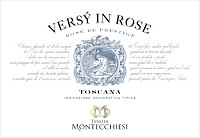
|
|
Versy in Rose 2018 |
|
| Tenuta Montecchiesi (Tuscany, Italy) | |
 Syrah, Vermentino Syrah, Vermentino | |
| Price: € 28.00 | Score: |
 Brilliant pale pink and nuances of pale pink, very transparent. Brilliant pale pink and nuances of pale pink, very transparent. Intense, clean, pleasing and refined, starts with hints of cherry,
raspberry and cyclamen followed by aromas of apple, pink grapefruit, peach,
melon, plum, vanilla and mineral. Intense, clean, pleasing and refined, starts with hints of cherry,
raspberry and cyclamen followed by aromas of apple, pink grapefruit, peach,
melon, plum, vanilla and mineral.
 Crisp attack and however balanced by alcohol, good body, intense
flavors, agreeable. Crisp attack and however balanced by alcohol, good body, intense
flavors, agreeable.
 Persistent finish with flavors of cherry, raspberry and pink
grapefruit. Persistent finish with flavors of cherry, raspberry and pink
grapefruit.
 8 months in cask. 8 months in cask. |
|
 Pasta and risotto with fish, Broiled fish, Sauteed white meat, Fried fish Pasta and risotto with fish, Broiled fish, Sauteed white meat, Fried fish |
|
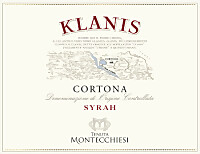
|
|
Cortona Syrah Klanis 2015 |
|
| Tenuta Montecchiesi (Tuscany, Italy) | |
 Syrah Syrah | |
| Price: € 28.00 | Score: |
 Intense ruby red and nuances of ruby red, little transparency. Intense ruby red and nuances of ruby red, little transparency. Intense, clean, pleasing and refined, starts with hints of black
currant, plum and black cherry followed by aromas of dried violet,
blueberry, blackberry, cocoa, tobacco, vanilla and eucalyptus. Intense, clean, pleasing and refined, starts with hints of black
currant, plum and black cherry followed by aromas of dried violet,
blueberry, blackberry, cocoa, tobacco, vanilla and eucalyptus.
 Properly tannic attack and however balanced by alcohol, good body,
intense flavors, agreeable. Properly tannic attack and however balanced by alcohol, good body,
intense flavors, agreeable.
 Persistent finish with flavors of black currant, plum and black cherry. Persistent finish with flavors of black currant, plum and black cherry. 16 months in cask, 10 months in bottle. 16 months in cask, 10 months in bottle. |
|
 Broiled meat and barbecue, Stewed meat with mushrooms, Roasted meat, Cheese Broiled meat and barbecue, Stewed meat with mushrooms, Roasted meat, Cheese |
|
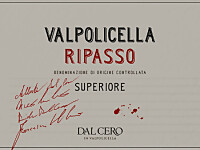
|
|
Valpolicella Ripasso Superiore 2016 |
|
| Dal Cero (Veneto, Italy) | |
 Corvina, Rondinella, Molinara Corvina, Rondinella, Molinara | |
| Price: € 22.00 | Score: |
 Brilliant ruby red and nuances of garnet red, little transparency. Brilliant ruby red and nuances of garnet red, little transparency. Intense, clean, pleasing and refined, starts with hints of blackberry,
plum and dried violet followed by aromas of black cherry, blueberry,
chocolate, tobacco, thyme, vanilla and menthol. Intense, clean, pleasing and refined, starts with hints of blackberry,
plum and dried violet followed by aromas of black cherry, blueberry,
chocolate, tobacco, thyme, vanilla and menthol.
 Properly tannic attack and however balanced by alcohol, good body,
intense flavors, pleasing roundness. Properly tannic attack and however balanced by alcohol, good body,
intense flavors, pleasing roundness.
 Persistent finish with flavors of plum, blackberry and black cherry. Persistent finish with flavors of plum, blackberry and black cherry. 12 months in cask. 12 months in cask. |
|
 Roasted meat, Stewed and braised meat, Broiled meat and barbecue, Cheese Roasted meat, Stewed and braised meat, Broiled meat and barbecue, Cheese |
|
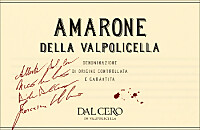
|
|
Amarone della Valpolicella 2013 |
|
| Dal Cero (Veneto, Italy) | |
 Corvina, Rondinella, Molinara Corvina, Rondinella, Molinara | |
| Price: € 50.00 | Score: |
 Intense ruby red and nuances of garnet red, little transparency. Intense ruby red and nuances of garnet red, little transparency. Intense, clean, pleasing, refined and elegant, starts with hints of
blackberry, plum and dried violet followed by aromas of black cherry,
blueberry, cocoa, tobacco, mace, cinnamon, leather, licorice, vanilla and
menthol. Intense, clean, pleasing, refined and elegant, starts with hints of
blackberry, plum and dried violet followed by aromas of black cherry,
blueberry, cocoa, tobacco, mace, cinnamon, leather, licorice, vanilla and
menthol.
 Properly tannic attack and however balanced by alcohol, full body,
intense flavors, pleasing roundness. Properly tannic attack and however balanced by alcohol, full body,
intense flavors, pleasing roundness.
 Persistent finish with flavors of plum, blackberry and black cherry. Persistent finish with flavors of plum, blackberry and black cherry. 4 years in cask. 4 years in cask. |
|
 Game, Braised and stewed meat, Roasted meat, Hard cheese Game, Braised and stewed meat, Roasted meat, Hard cheese |
|
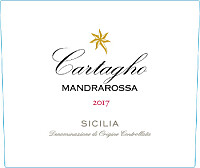
|
|
Sicilia Rosso Mandrarossa Carthago 2017 |
|
| Cantine Settesoli (Sicily, Italy) | |
 Nero d'Avola Nero d'Avola | |
| Price: € 18.00 | Score: |
 Intense ruby red and nuances of ruby red, little transparency. Intense ruby red and nuances of ruby red, little transparency. Intense, clean, pleasing and refined, starts with hints of plum,
blackberry and black cherry followed by aromas of dried violet, blueberry,
tobacco, carob, mace, vanilla and menthol. Intense, clean, pleasing and refined, starts with hints of plum,
blackberry and black cherry followed by aromas of dried violet, blueberry,
tobacco, carob, mace, vanilla and menthol.
 Properly tannic attack and however balanced by alcohol, good body,
intense flavors, agreeable. Properly tannic attack and however balanced by alcohol, good body,
intense flavors, agreeable.
 Persistent finish with flavors of plum, blackberry and black cherry. Persistent finish with flavors of plum, blackberry and black cherry. 12 months in barrique, 4 months in bottle. 12 months in barrique, 4 months in bottle. |
|
 Roasted meat, Braised and stewed meat with mushrooms, Hard cheese Roasted meat, Braised and stewed meat with mushrooms, Hard cheese |
|
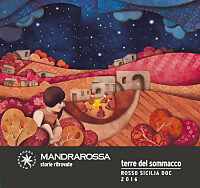
|
|
Sicilia Rosso Mandrarossa Terre del Sommacco 2016 |
|
| Cantine Settesoli (Sicily, Italy) | |
 Nero d'Avola Nero d'Avola | |
| Price: € 19.00 | Score: |
 Brilliant ruby red and nuances of ruby red, little transparency. Brilliant ruby red and nuances of ruby red, little transparency. Intense, clean, pleasing, refined and elegant, starts with hints of
plum, blackberry and black cherry followed by aromas of dried violet,
blueberry, carob, tobacco, chocolate, tamarind, mace, vanilla and menthol. Intense, clean, pleasing, refined and elegant, starts with hints of
plum, blackberry and black cherry followed by aromas of dried violet,
blueberry, carob, tobacco, chocolate, tamarind, mace, vanilla and menthol.
 Properly tannic attack and however balanced by alcohol, good body,
intense flavors, agreeable. Properly tannic attack and however balanced by alcohol, good body,
intense flavors, agreeable.
 Persistent finish with flavors of plum, blackberry and black cherry. Persistent finish with flavors of plum, blackberry and black cherry. 8 months in steel and cement tanks, 19 months in cask, 8 months in
bottle. 8 months in steel and cement tanks, 19 months in cask, 8 months in
bottle.
|
|
 Roasted meat ,Broiled meat and barbecue, Stewed meat with mushrooms, Cheese Roasted meat ,Broiled meat and barbecue, Stewed meat with mushrooms, Cheese |
|
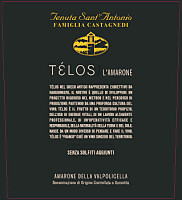
|
|
Amarone della Valpolicella Telos 2015 |
|
| Tenuta Sant'Antonio (Veneto, Italy) | |
 Corvina (70%), Rondinella (20%), Croatina (5%), Oseleta (5%) Corvina (70%), Rondinella (20%), Croatina (5%), Oseleta (5%) | |
| Price: € 34.90 | Score: |
 Intense ruby red and nuances of garnet red, little transparency. Intense ruby red and nuances of garnet red, little transparency. Intense, clean, pleasing, refined and elegant, starts with hints of
plum, blackberry and dried violet followed by aromas of black cherry,
blueberry, carob, tobacco, cocoa, tamarind, coffee, licorice, vanilla and
menthol. Intense, clean, pleasing, refined and elegant, starts with hints of
plum, blackberry and dried violet followed by aromas of black cherry,
blueberry, carob, tobacco, cocoa, tamarind, coffee, licorice, vanilla and
menthol.
 Properly tannic attack and however balanced by alcohol, full body,
intense flavors, pleasing roundness. Properly tannic attack and however balanced by alcohol, full body,
intense flavors, pleasing roundness.
 Persistent finish with flavors of plum, blackberry and black cherry. Persistent finish with flavors of plum, blackberry and black cherry. 16 months in cask. 16 months in cask. |
|
 Game, Roasted meat, Stewed and braised meat, Hard cheese Game, Roasted meat, Stewed and braised meat, Hard cheese |
|
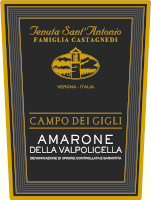
|
|
Amarone della Valpolicella Campo dei Gigli 2015 |
|
| Tenuta Sant'Antonio (Veneto, Italy) | |
 Corvina, Corvinone (70%), Rondinella (20%), Croatina (5%), Oseleta (5%) Corvina, Corvinone (70%), Rondinella (20%), Croatina (5%), Oseleta (5%) | |
| Price: € 51.70 | Score: |
 Intense ruby red and nuances of garnet red, little transparency. Intense ruby red and nuances of garnet red, little transparency. Intense, clean, pleasing, refined and elegant, starts with hints of
plum, blackberry and dried violet followed by aromas of black cherry,
blueberry, walnut husk, chocolate, tobacco, carob, cinnamon, licorice,
leather, mace, vanilla and menthol. Intense, clean, pleasing, refined and elegant, starts with hints of
plum, blackberry and dried violet followed by aromas of black cherry,
blueberry, walnut husk, chocolate, tobacco, carob, cinnamon, licorice,
leather, mace, vanilla and menthol.
 Tannic attack and however balanced by alcohol, full body, intense
flavors, pleasing roundness. Tannic attack and however balanced by alcohol, full body, intense
flavors, pleasing roundness.
 Very persistent finish with long flavors of plum, blackberry and black
cherry. Very persistent finish with long flavors of plum, blackberry and black
cherry.
 3 years in cask. 3 years in cask. |
|
 Game, Roasted meat, Braised and stewed meat, Hard cheese Game, Roasted meat, Braised and stewed meat, Hard cheese |
|
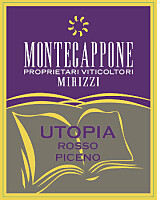
|
|
Rosso Piceno Utopia 2015 |
|
| Montecappone (Marches, Italy) | |
 Montepulciano Montepulciano | |
| Price: € 25.00 | Score: |
 Deep ruby red and nuances of ruby red, little transparency. Deep ruby red and nuances of ruby red, little transparency. Intense, clean, pleasing, refined and elegant, starts with hints of
plum, blueberry and black cherry followed by aromas of dried violet,
blackberry, cocoa, tobacco, cinnamon, leather, licorice, vanilla and
eucalyptus. Intense, clean, pleasing, refined and elegant, starts with hints of
plum, blueberry and black cherry followed by aromas of dried violet,
blackberry, cocoa, tobacco, cinnamon, leather, licorice, vanilla and
eucalyptus.
 Properly tannic attack and however balanced by alcohol, good body,
intense flavors, agreeable. Properly tannic attack and however balanced by alcohol, good body,
intense flavors, agreeable.
 Persistent finish with flavors of plum, blueberry and black cherry. Persistent finish with flavors of plum, blueberry and black cherry. 18 months in barrique, 6 months in bottle. 18 months in barrique, 6 months in bottle. |
|
 Roasted meat, Broiled meat and barbecue, Stewed meat with mushrooms, Cheese Roasted meat, Broiled meat and barbecue, Stewed meat with mushrooms, Cheese |
|
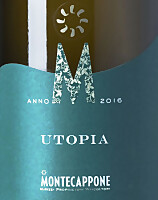
|
|
Castelli di Jesi Verdicchio Riserva Classico Superiore Utopia 2016 |
|
| Montecappone (Marches, Italy) | |
 Verdicchio Verdicchio | |
| Price: € 20.00 | Score: |
 Brilliant straw yellow and nuances of straw yellow, very transparent. Brilliant straw yellow and nuances of straw yellow, very transparent. Intense, clean, pleasing, refined and elegant, starts with hints of
apple, plum and citron followed by aromas of pear, hawthorn, peach,
pineapple, broom, medlar, jasmine, linden, saffron, thyme, anise and
almond. Intense, clean, pleasing, refined and elegant, starts with hints of
apple, plum and citron followed by aromas of pear, hawthorn, peach,
pineapple, broom, medlar, jasmine, linden, saffron, thyme, anise and
almond.
 Crisp attack and however balanced by alcohol, good body, intense
flavors, agreeable. Crisp attack and however balanced by alcohol, good body, intense
flavors, agreeable.
 Very persistent finish with long flavors of apple, plum and citron. Very persistent finish with long flavors of apple, plum and citron. 9 months in steel tanks. 9 months in steel tanks. |
|
 Pasta with fish, Sauteed white meat, Stewed fish, Fried fish, Cheese Pasta with fish, Sauteed white meat, Stewed fish, Fried fish, Cheese |
|
|
||||||||
|
DiWineTaste Polls
|
| |||||||
Privacy Policy | |||||||


| Copyright © 2002-2024 Antonello Biancalana, DiWineTaste - All rights reserved |
| All rights reserved under international copyright conventions. No part of this publication and of this WEB site may be
reproduced or utilized in any form or by any means, electronic or mechanical, without permission in writing from DiWineTaste. |